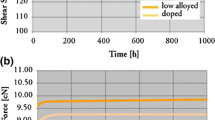Abstract
Fine gold wires with diameters down to 15μm are used for bonding semiconductor devices. Increasing miniaturization of electronic circuits calls for smaller wire diameters. This requires the development of gold wires with increased mechanical strength and good bondability to replace thicker wire diameters without detriment to their functionality. The first gold bonding wires were pure gold, and then doped gold wires of high purity were developed because of their stabilized and improved mechanical characteristics. Nowadays and in the near future low alloyed gold wires are increasingly replacing doped gold wires. This paper gives an overview of the mechanical characteristics of doped and low-alloyed gold bonding wires and their bondability.
Similar content being viewed by others
References
AVT Report 4, Technologie des Drahtbondens, Germany, August 1991
‘High Technology Bonding Tools’, Gaiser Tool Company, Ventura, California, 1989
W. Kohl, ‘The Interaction of Material and Machine Parameters in Thermosonic Bonding’, translation of a reprint from ‘Der Elektroniker’ Issue 6/1990, AT-Fachverlag, Stuttgart, Germany, 1991
Merkblatt DVS 2810 Drahtbonden, (instructional leaflet, wire bonding), Germany, 1992
S. Tomiyama and Y. Fukni,Gold Bull., 1982,15 (2), 43
W. Kohl, ‘Metallurgical Aspects of Wire Bonding’, printed by Heraeus, 1990
ASTM-F72
Japanese Patent Application 5-179375 A
Japanese Patent Application 5-179376 A
T.H. Ramsey,Solid State Technology, 1973, Oct, 43–47
German Patent Application DE 3936281 A1
European Patent Application 0743679 A2
German Patent 1608 161
US Patent 5 491 034
Japanese Patent 6-112251
European Patent 0288 776
German Patent Application DE 197 33 954 A1
European Patent Application 0761 831 A1
Japanese Patent Application 52-051867 A
T.B. Massalski, ‘Binary Alloy Phase Diagrams’, 2nd Ed., ASM International, Ohio, USA, 1990
Merkblatt DVS 2807 Teil 1, Zusatzwerkstoffe für Mikroverbindungen, Bonddrähte und Bändchen, (instructional leaflet, Addition Materials for Microjoints, Bonding Wires and Ribbons), Germany, 1992
D. Ott and Ch. J. Raub,Gold Bull., 1981,14 (2), 69
D.M. Jacobson, M.R. Harrison, S.P.S. Sangha,Gold Bull., 1996,29 (3), 95
G. Humpston and D.M. Jacobson,Gold Bull., 1992,25 (4), 132
W. Kohl, S. Weber and A. Bischoff, ‘Metallographic Investigation of the Au-Al Intermetallic Phase Formation, Metallography Conference of Deutsche Gesellschaft für Metallkunde, Garmisch-Partenkirchen, Germany, 1988
V. Koeninger and E. Fromm, ‘Einflüsse von Alterung und Kontamination auf die Degradation von Gold-Aluminium-Ballbonds’, (Influence of Ageing and Contamination on the Degradation of Gold-Aluminum Ball Bonds), Verbindungstechnik in der Elekronik und Feinwerktechnik, Düsseldorf, DVS-Verlag, 1996,8 (4), 193
E.M. Philofsky,Solid-State Electronics, 1970,13, 1391
G. Majni and G. Ottaviani,J. Crystal Growth, 1979,47, 583
P.K. Footner, B.P. Richards and R.B. Yates,Quality and Reliability Engineering International, 1987, 3, 177
MIL-STD-883E
A. Russell, K. Xu, S. Chumbley, J. Parks and J. Harringa,Gold Bull., 1998,31, (3), 88
M. Judge, New Scientist, 1997, March 8th, pp 37
M. Poniatowski and M. Clasing,Gold Bull., 1972,5 (2), 34
C.W. Corti,Gold Bull., 1999,32 (2), 39
Author information
Authors and Affiliations
Rights and permissions
About this article
Cite this article
Simons, C., Schräpler, L. & Herklotz, G. Doped and low-alloyed gold bonding wires. Gold Bull 33, 89–96 (2000). https://doi.org/10.1007/BF03215484
Received:
Issue Date:
DOI: https://doi.org/10.1007/BF03215484



